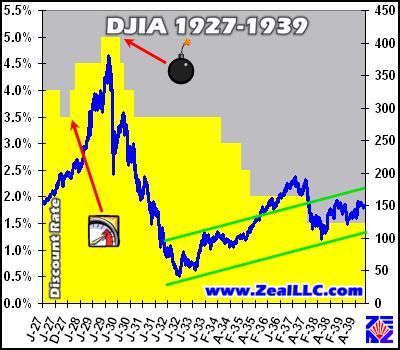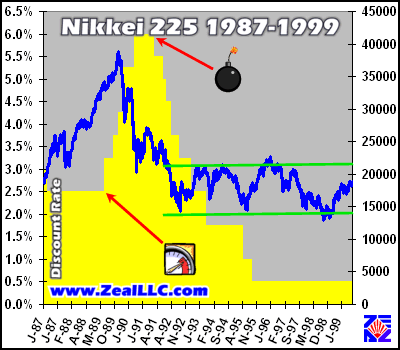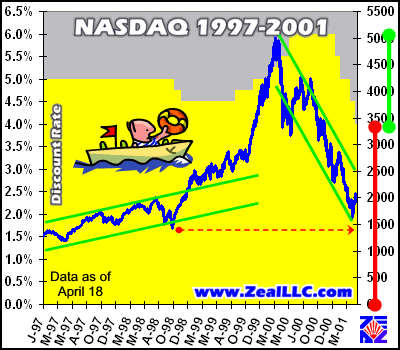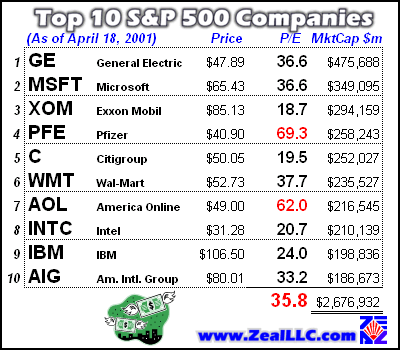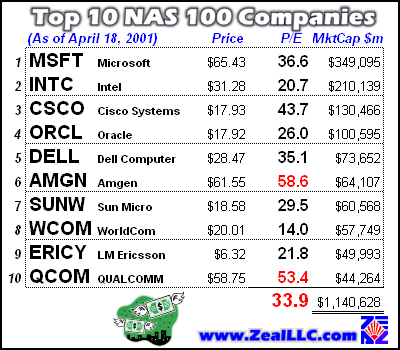|
|
|||||||
|
|
|
|
|
|
|
|
|
|
Emergency Rate Cut Numero Dos Adam Hamilton April 20, 2001 4697 Words
April 18, 2001. A day that will live forever in financial market infamy. Just when we were beginning to think that the markets could not possibly grow much more surreal and wacky, they did…
Dateline 18 April 2001 0830 EDT. Through the modern technological miracle of the conference call, Sir Alan Greenspan conferred with his band of merry marauders on the Federal Open Market Committee. No one knows exactly what they discussed, as the elite bankers at the private bank entrusted with the incredibly important US economy are not accountable to the citizens of the United States of America or our elected representatives. In the hastily called emergency meeting, we can only know for certain that Greenspan made a decision… CHARGE!
Following the discussion at the virtual round table, Greenspan donned his shiny armor and buckled on his fearsome weapons. He then mounted his mighty war steed, Monetary Policy. Suited up and ready for action, Knight Greenspan rallied his troops. In a bellowing voice he shouted, “Moral hazard be damned! The time has come to rout out the bane of these markets, those infernal short sellers.” A great bloodthirsty cry of joy collectively resounded into the sky from the Knights of the FOMC Round Table. With one final bloodcurdling war cry, Greenspan leveled his 50 basis point lance and charged and the galloping herd of FOMC armored cavalry shook the countryside like rolling thunder.
Meanwhile, the Barons and Lords of Wall Street, those unfortunate multi-millionaires who Greenspan and his posse were desperately riding to save, were having a rough time. After all, the crucial kingdoms of Cisco and Intel had just been shaken with news of internal strife and dismal business environments. The Masters of the Universe on Wall Street were getting scared. They feared that the mere peasants, the average middle-class American investor, would desert the leadership of Wall Street and sell their shares en masse. Such an event would be “The End of the World” from a Wall Street perspective!
The Wall Street Barons were usually good at leading the average naive investors around by their noses like a herd of retarded sheep, but they feared a peasant revolt as 401(k) statements laid bare the devastating market performance of the first quarter. The Lords of Wall Street had begged, had pleaded on their knees, that their savior, the privately held United States Federal Reserve Bank, would ride to the rescue. They had just about given up on their impassioned pleas for help, when suddenly, on the horizon, stood Knight Greenspan and his riders, lances held high, glinting in the midday sunlight. A cheer of joy erupted on Wall Street. The saviors of the market had once again come to protect the Wall Street Barons.
On the hillside, surveying the ongoing bull and bear battle in the market below, Greenspan shouted to his men, “Scourge the bears, kill them all, run your lances through their cold black hearts with no remorse, but don’t hurt our friends the bulls.” The armored cavalry charged, and the bears looked up from their battle and saw the emergency interest rate cut ripping through their ranks like a mighty Grim Reaper’s scythe. Many bears fell in the ensuing melee. Shorts were covered, bears were slaughtered, and blood covered Wall Street.
A weary Greenspan took off his gilded helmet and trotted over to confer with the Barons of Wall Street. They obsequiously bowed at the feet of his war steed and profusely thanked him for smiling on them. Knight Greenspan’s armor was covered with blood and gore and bear fur, and he was a sight to behold. He said, “Fear not, gentle Wall Street Barons. We at the Fed will continue to backstop all your silly bets on fundamentally overvalued stocks. You have nothing to fear, as the Fed is here.” The Wall Street Barons cheered, and Greenspan and his horsemen of bearish destruction rode off into the sunset, presumably to reappear May 15, or maybe before, if conditions warrant…
It was a wild day, dear reader. Lest you think our little parable is too harsh and the FOMC is actually truly democratic and the Fed Governors openly and honestly vote on what action to take, we highly recommend the excellent book by legendary journalist Bob Woodward, “Maestro”. Maestro is an easy read and describes the iron-fisted reign of Greenspan over the Fed since his appointment in 1987. Bob Woodward does not name his sources, but we suspect he is right on the money with his view of the Federal Reserve. Woodward paints a picture of a domineering Alan Greenspan, unilaterally making all the decisions for the FOMC and brooking no dissent. Woodward describes in remarkable detail the 13 years of Fed decisions between 1987 and 2000.
The book is EXTREMELY interesting in light of the current Fed panic easing cycle. For those who think that the free markets are entirely “free”, Woodward describes numerable examples of blatant market manipulation in the past decade, giving specific names and circumstances. Woodward mentions MANY of the defendants of Reg Howe’s landmark complaint against the gold shorts in his book, in situations where they artificially moved markets in the past decade. Most importantly of all, perhaps, Maestro drives home the point that the Fed IS Alan Greenspan, and Alan Greenspan is the Fed.
The $64,000 question about yet another emergency rate cut is… WHY?
The Fed usually makes a cryptic statement with its rate cuts, but these seem like smoke and mirrors. Like a master illusionist, it seems Greenspan usually tries to keep the markets off guard by diverting attention from the true reasons for interest rate moves. The Fed seduces you into looking at its right hand holding the magic hat with the bunny rabbit, all the while the left hand is really where the true action is. The Fed apparently fears that if the markets really know why it acts, that they would understand how fragile the economy and interconnected Wall Street establishment truly is. Psychology is far beyond important in our modern market environment.
The last time Greenspan surprised the markets with an inter-meeting emergency rate cut seems like yesterday, January 3rd. At the time, the bulls heralded it as “The Bottom” and were giddy with excitement about the new bull market. We wrote an essay on that rate cut at the time called “Greenspan Gambit”. We had the audacity and gall to say that the rate cuts would not help because fundamentals were atrocious. On market close January 3rd, The NASDAQ was around 2600, the DJIA was around 11000, and the S&P 500 was around 1350. Looking back at the past three and a half months, the interest rate cuts sure did not live up to stellar bullish expectations!
In that earlier essay, we also asked the question WHY. Two possibilities seemed probable then, and the same two possibilities probably explain the current emergency rate cut as well.
One, Greenspan and his gang had inside information about imminent bank or hedge fund failures and they feared a cascading cross default. Most people are unaware of how interconnected and fragile our highly leveraged and interdependent global financial system really is. Bob Woodward’s “Maestro” also does a masterful job of explaining past financial crises like the Long-Term Capital Management debacle and how dangerous they really are. If the Fed knows a major Wall Street player is on the ropes, they are virtually forced to act or else risk the entire system imploding.
Now if the Fed knew some big player was in trouble, it is at least plausibly justifiable to make big inter-meeting rate cuts. The second possibility, however, is the truly scary alternative answer to the vexing WHY question.
Two, Greenspan is manipulating monetary policy solely with the short-term stock market in mind. Like a manager at a large company manipulating earnings each quarter to meet expectations, could Greenspan really be just throwing a bone to the speculators? Could the same Greenspan who complained of “irrational exuberance” FIVE years ago now be backstopping the trades of the leveraged bullish speculators? This possibility is truly frightening. It creates a “moral hazard” of epic proportions that can only end very badly.
In the “dismal science” of economics, moral hazard simply means that an entity takes risks far beyond what is prudent because it believes it will be rescued if the trade moves the wrong way. The Greenspan Fed has bailed out innumerable big Wall Street players in its short history. The US savings and loan system, the US banks that loaned money to Mexico, the US banks that loaned money to Asia, the US banks that loaned money to Russia, Long-Term Capital Management, etc. Woodward details all of these events in his book. Alan Greenspan has always been there to rescue players that are “too big to fail”. The net result of all this blatantly anti-free market behavior is the big players have come to the point where they just assume they can make risky bets because the Fed will backstop their silly trades.
Wall Street calls it “The Greenspan Put”, and it is well known throughout the US stock markets. Unfortunately, capitalism will ONLY work when traders, big and small, have to face the consequences of their bets, win or lose. Capitalism cannot work efficiently when risk and accountability for an entity’s market actions are magically erased by the US Federal Reserve.
If the second surprise rate cut is simply to bolster mania-type psychology and encourage speculation in still ludicrously overvalued stocks, it is awfully frightening. Even if that was not Greenspan’s intention, it was the result. The biggest gains the day of the rate cut were not in traditional companies making money that can truly benefit from a rate cut, instead the speculative hot money poured back into the frothy already massively overvalued tech stocks after the rate cut. Companies trading at more reasonable valuations tended to be sold off on the day as money lusted after the tech stocks once again. If Greenspan cut rates to manipulate the stock market, the US is in a world of hurt.
Another important question also arises, why do the markets jump so aggressively at rate cuts? Sure, net present value calculations are slightly higher with lower “risk-free “ rates of return in the equation, but there is no tangible immediate effect from a rate cut. Most economists believe interest rate changes take 9-12 months to filter into the real economy in a tangible way. If that is the case, why bid up companies 10%-20% in a few hours on mere news of rate cuts? Obviously, the immediate effect is purely psychological and the market moves are almost entirely speculative and not based on changed fundamentals.
Speaking of fundamentals, did anything change on April 18? US companies still face a rapidly softening economy, deteriorating earnings, and are still fundamentally overvalued by all historical measures. As contrarian legend Bill Fleckenstein often points out, stocks are not just pieces of paper, but fractional ownership interests in living, breathing businesses. Over the long run, the only thing that matters in any stock is the cash it can spin off for its owners. Did the cashflow picture for the entire US markets suddenly improve on a small half point rate cut? Core market fundamentals were the same on April 19 as on April 17. Nothing real had changed.
Greenspan’s unilateral inter-meeting action seems to spit in the eye of fundamentals and encourage leveraged speculators to bet that the Fed will “save the markets”. After all, if Greenspan wanted to use the same gradualist approach that has been his hallmark, he could have simply waited a few more weeks until May 15 to cut rates. In the grand scheme of things, a surprise emergency rate cut will ultimately have no more or no less effect than a less panicked interest rate cut during a normally scheduled FOMC meeting.
Another interesting anomaly regarding the interest rate cuts is the typical bullish partly line that “markets always go up when the Fed cuts interest rates”. The bullish high priests and acolytes paraded on bubblevision seem extremely confident in their oft-stated assertion that interest rate cuts always are bullish for equity prices.
It is especially ironic, from our perspective, that now that even more and more of the bulls are admitting the NASDAQ was a bubble last year, very few have apparently taken the time to study the great historical bubbles of the twentieth century. If even the rabid perma-bulls are now becoming convinced that last year saw a mighty speculative bubble, one would assume they would study the interest rate environments surrounding past bubbles, perhaps. Alas, however, only a few lonely contrarians seem to still think that financial truth, financial history, and immutable fundamentals still matter.
The following two graphs are shamelessly ripped from our recent essay “Bubbling Interest Rates”, which was a study of interest rates during historic bubble booms and busts. The first graph outlines the interest rate environment in the United States surrounding the infamous 1929 bubble. The yellow columns represent the discount rate and are tied to the left axis. The blue line is the DJIA in this first graph. Green lines are trend channels. The overheating gauge represents the time when the Federal Reserve realized, “Uh, hey fellas, looks like we created a monster here. Let’s put a silver bullet in this beast before someone notices.” That is the point where they started raising interest rates to cool off the mania. The bomb icon, on the other hand, represents the point in time when an Edisonian lightbulb appeared over the heads of the Fed and they thought, “Oh no, we really blew it. This bubble is bursting and we have to save it.” Needless to say, that is when they started frantically slashing interest rates. For a much more in-depth explanation of these graphs, please check out our “Bubbling Interest Rates” essay.
Wow. Interest rate cuts sure did a lot of good in 1929, eh? Makes one wonder if the bullish propaganda folks even know 1929 existed!
Many socialist, pro-market manipulation, Keynesian economists today claim that the post-1929 bust happened because the Fed was too tight. It is interesting to note that the Fed only cut the discount rate three times immediately after the 1929 burst. The rare equity bulls today who actually have studied any history after grade school sometimes claim that if the Fed would have only cut more decisively following 1929, the bust never would have happened.
Maybe our Japanese friends can shed a little light on that fanciful assertion. Here is a graph of the Nikkei 225 showing its bubble, burst, and bust.
The Japan Central Bank, fully steeped in Keynesian “logic”, realized that they had to open liquidity floodgates FAST to attempt to stave up the rapidly deflating bubble. They frantically slashed the discount rate not three, not four, but NINE times following the bubble burst. Today, more than a decade after the bubble, Japanese interest rates are at ZERO. There is no cost to borrow money. Yet, the Nikkei still is trading around a dismal 13500, merely a third of its 1989 high! Maybe interest rate cuts are NOT a panacea for bubble bursts…
The bulls praying that the current bubble in the States will turn out differently are wishful thinkers, caught in a fantasy land. They have zero historical precedent for their oft-repeated mantra that interest rate cuts can save the imploding NASDAQ bubble. This next graph is updated from the “Bubbling Interest Rates” essay with current data up to the April 18 Emergency Rate Cut Numero Dos.
As Greenspan rushes to the rescue in his fast attack boat, a few important points leap out of the graph. First, note the red dashed horizontal line in the middle of the graph. It extends from the 1998 lows of the NASDAQ to our current surreal moment in financial market history. Now, honestly, does anyone out there REALLY believe that the bottom of a bear market after a Kondratieff bubble burst will happen ABOVE 1998 lows? Will the biggest bubble in the history of the universe end after only wiping out two years of gains? Not a chance. ALL historical bear markets, especially after speculative manias, ultimately regress to ten to fifteen year bear market lows.
What’s a real NASDAQ low? In 1990 the lowest daily closing level of the NASDAQ composite index was 325 on October 16. REAL bear markets, especially after historic manias, wipe out over a decade of gains, not just a couple years. The incorrigible perma-bulls who dream the NASDAQ can bottom above 1998 levels must be smoking some of that wacky weed they pass out on Wall Street.
Second, note the steep downward trend channel of the NASDAQ since the burst, bound by the green lines on the right side of the graph. No rally since the initial double bounce has broken the top of this trend, INCLUDING the January Emergency Rate Cut Numero Uno induced frenzied rally. Like drugs, each successive “hit” on the interest rate cut needle has less and less of a high effect for the equity bull junkies. We would be VERY surprised if this current rally has the legs to jump out of this downward flat-spin trading channel.
Finally, notice the vertical red and green lines on the right side of the graph covering the NASDAQ composite levels. They correspond to the yellow interest rate data. The green line represents the 200 basis points of rate cuts Greenspan has already burned through in only 15 short weeks! The red line represents the remaining 400 possible basis points to go. As the Japanese found out the hard way, low interest rates are NOT a financial market panacea. Greenspan has squandered the most important third of his ammunition already, and this bear is just waking up!
Of course, if the US markets are really undervalued, as famous bullish high priests (and priestesses, Abby) are telling their clients, then the case for a rally can be advanced. Unfortunately, however, the biggest and brightest US companies are almost all STILL valued at mania-type levels in the context of financial market history. Here are the P/Es of the ten biggest and best companies in the United States.
The average P/E of this mighty group was an astounding 35.8 on the day of the second emergency interest rate cut! In last week’s “Contrarian Earnings Season” essay, we explained in more detail why this is so overvalued in context of cashflow realities and historical precedent, and how bear markets typically bring the stock market down to an average P/E well below the 13.5x “fair value” mark. These S&P 500 monoliths ALL have a long way to fall before they get even close to being a “great value”, contrary to bullish assertions to the opposite constantly spouted on the financial media.
The NASDAQ 100, the biggest and best of the highly speculative companies listed on the NASDAQ, do not look much better.
An average P/E of 33.9 is stupendously high by all pre-2000 bubble historical standards, even for the blue-sky NASDAQ. Also, ominously, neither of these two charts reflects the new earnings released for the first quarter. Most of these companies’ P/Es would leap northward if current earnings releases were factored in. There are very few reasonable valuations in the vast majority of stocks in the NASDAQ 100, the S&P 500, OR the Dow 30 at this moment in time. We are still at mania extremes and have a long way down to go to a normal bear market bottom.
Of course, the bulls may object yet again and claim that the individual company stories are more important than the strategic big picture in the aggregate. They may claim that companies should be examined individually, and not lumped into macro valuation models. We agree.
To placate the bulls, we will drill down and take a brief tactical look at one market darling and current champion of the perma-bulls, Intel. After all, Intel’s earnings multiple shown above is nowhere near as bad as most of the other companies’ P/Es, so maybe it is in good shape as the bulls claim.
Intel, INTC, is a tremendously important US company. It is THE premier designer and manufacturer of computer central processing units (CPUs) in the world. Intel is one of the biggest companies on the planet in terms of market capitalization. It is a member of the esteemed S&P 500, the second biggest stock on the NASDAQ and NASDAQ 100, and even an elite blue-chip company listed on the venerable Dow 30. Intel processors have been the engines that have powered the dawn of the Information Age.
The typical Wall Street “fundamental analysis” for Intel is summed up as follows, “Computer demand should grow this year as consumers spend more money and businesses upgrade computers. Intel will benefit from this, therefore now is a ‘great buying opportunity’ for Intel.”
Before we wade into the fray, some important disclosures are in order. Neither myself, my company, nor my partners have any positions or bets on Intel, directly or indirectly, long or short. We have never taken a short position on Intel itself and have never recommended that our clients take a short position on Intel. We have been using Intel products everyday for 20 years, since the early 8086 days, and we simply love Intel-based computers. As we are all computer junkies, we buy new computers annually and 100% of them have the latest Intel chips inside. We are addicted to Intel technology. Personal warm and fuzzy feelings aside, however, we invest and speculate in the markets for one reason, to make money. Here are some shooting-from-the-hip fundamental thoughts on Intel as an investment…
Intel announced its latest quarterly results this week and they were absolutely DISMAL. Intel’s first quarter income plummeted 82% in the slowing economic environment. It reported profits of 7 pennies per share (16 cents excluding acquisition costs), down from 43 cents in the same quarter last year. From any objective measure, Intel’s real performance was disastrous. If Intel was to make 7 cents a share for the next three quarters, it would be currently trading at an eye-popping P/E of over 111 times earnings, approaching the levels of the dot coms of lore. If the economic environment continues to deteriorate in the US, as we expect, Intel may even scrape up LESS than 7 cents per share in future quarters.
Intel also announced it would probably slash the price of its flagship Pentium IV processor by up to 50%. That, by necessity, would cut Intel’s profit margins on these lucrative new chips by over 50%. Is it good news when a company announces they cannot even sell their premium product so they have to almost give it away? Not from our perspective.
Yet, after this news broke, Intel rocketed up 11% in after hours trading. Wall Street hucksters considered this horrible showing a success because Intel had slightly “exceeded” drastically lowered expectations. On April 18, the day after this bad news, Intel rocketed up $5.24, an additional 20%. Wall Street perma-bull analysts did their best to convince the public that the “worst was over” and there were blue-skies ahead for Intel. Really?
As we noted before, the Wall Street bullish case is based on the assertion that consumer spending will accelerate so more computers (and hence Intel chips) will be sold. We laugh at this and wonder what money consumers will use to buy computers. US consumers are tapped out, leveraged to the hilt, drowning in debt, and being laid off by the hundreds of thousands. We detailed their plight in our recent “Consumers to Rescue Wall Street?” essay. As we all know, computers aren’t cheap, and consumers are not going to be buying shiny new computers rather than eating and paying their energy bills or servicing their huge debts. If consumers don’t have the money and can’t borrow more to buy computers, the market for Intel will slow far more than it is even today.
In addition, Intel’s latest Pentium IV chip has not sold very well. Sales have been very slow, and not only because of the slowing economy.
Respected computer industry publications have run benchmark after benchmark and the latest 1.5ghz Pentium IVs fall short of 1.2ghz and 1.3ghz chips made by archrival Advanced Micro Devices (AMD). Some benchmarks have even shown the old 1ghz Pentium III is faster than the new Pentium IV! Ouch. To make matters worse, the faster AMD chips are typically less than half the price of the premium-priced Pentium IV chips. The Pentium IV also runs hot and has thermal management problems. If the chips get too hot, they simply shut down half the time. They run 2 milliseconds and then cycle down for 2 milliseconds, in order to keep from literally burning up. When in thermal management mode, the Pentium IV chips only run at an effective speed of 0.75ghz, half their advertised speed. Why buy a new Pentium IV based computer when it performs worse than your existing 1ghz Pentium III chip on existing software?
The Pentium IV chips are also not designed for symmetric multi-processing, meaning running multiple chips in the same computer for more performance. This significant limitation severely limits Intel’s ability to sell them into the lucrative high-end workstation market. Pentium IVs also require very expensive Rambus RDRAM, which costs many times as much as conventional SDRAM yet currently yields only trivial gains in performance. With all the problems with the Pentium IV, many information technology professionals are saying they will NOT upgrade their businesses to the new chips. IT professionals realize that the average office computer user will notice no difference in performance between their existing Pentium III based machines versus the expensive new Pentium IV boxes, so why upgrade?
With consumers tapped out, and information technology professionals seeing a Pentium IV that does not live up to expectations, who is left to buy the new chips and rescue Intel? These are IMPORTANT fundamental questions that you will never hear on bubblevision. It only takes about ten minutes on the Web to find this information, so why are the Wall Street professionals not telling their clients? These are tough questions for Wall Street and bubblevision, the Official Ministry of Wall Street Bullish Propaganda. We are certainly glad all we own from Intel is its products and NOT its stock! And Intel is just one of MANY companies that look dismal fundamentally.
The bulls are in trouble, and interest rate cuts won’t save them.
Bottom line, Greenspan has embarked on an extremely dangerous inflationary policy to try and “save the markets”. Greenspan IS brilliant, and IS a student of history, so we have no doubt he is well aware of the risks involved from his aggressive actions. Greenspan has sent a very clear signal to the bond and gold markets that he is willing to risk raging inflation to salvage his personal reputation. He has painted a big bright red target on the back of the US dollar with the continuing emergency interest rate cuts. He has allowed the broad M3 US money supply to balloon a mind-numbing 12% since the bubble burst last March. These fiat dollars flooding the system are beginning to show up in US inflation, with the CPI raging at an annualized rate of 5% so far in 2001. Greenspan is telling the markets he will attempt to inflate himself out of the bubble he helped create.
Lower interest rates will ultimately ravage the dollar. Bond markets will begin to expect inflation. The lucrative gold carry trade becomes less and less profitable every time interest rates are lowered. With gold lease rates around 2%, the spread between gold and US treasuries is closing fast. The danger to the gold shorts becomes more and more extreme each time Greenspan slashes rates. The dollar becomes more vulnerable and the risk/reward equation of the gold carry tilts dangerously towards unadulterated risk.
The ultimate implications of Greenspan’s unabashedly pro-inflation policy for the US equity markets, the US bond markets, the US dollar, and gold will be VAST.
Adam Hamilton, CPA April 20, 2001 Subscribe |
|||||||
|
|
|
|
|
|
|
|
|
|
|
|
|
|
|
|||

